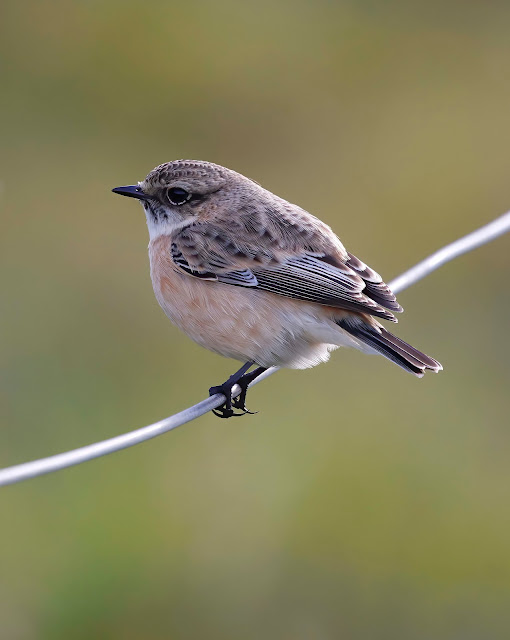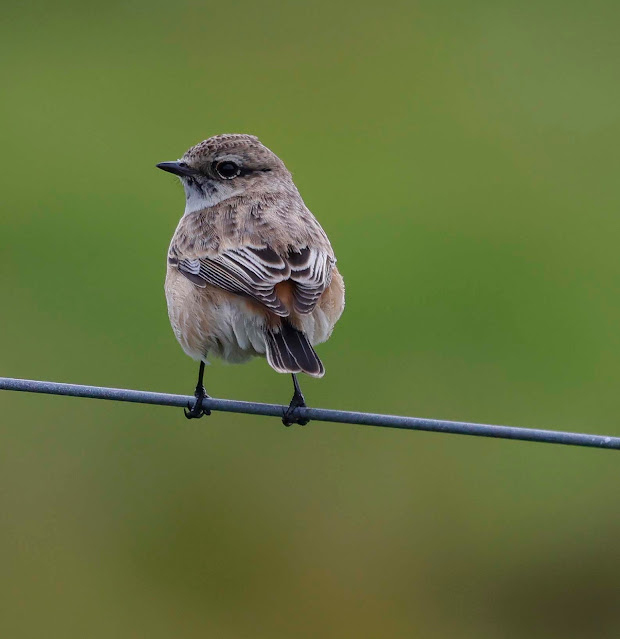3rd, 4th and 8th October - A Siberian Stonechat at Hamnavoe
I have more than a passing interest in stonechats having written the book 'Stonechats A Guide to the Genus Saxicola'. published in 2002. Years of studying skins of stonechats in the British Museum of Natural History at Tring in Hertfordshire gave me a special fondness for the frosted pale plumage of the Siberian examples.
When the book was published the Siberian Stonechat was considered to be one species but since then it has been split into two species, one breeding roughly west of Lake Baikal while the other breeds east of the lake. The Eastern form is now called Stejneger's Stonechat with recent moves to call it alternatively Amur Stonechat. The western form retains the name Siberian Stonechat. Let's leave it there.
A Siberian Stonechat was discovered frequenting rough fields at an isolated place on Lunna Ness called Hamnavoe, consisting of no more than two houses and an old run down croft, just a mile or two beyond Lunna where the Veery remained in residence.Obviously I had to go and see the stonechat as it would give an all too rare opportunity to study a live specimen in the field and from a personal point of view it would be nice to see a rare bird in a part of Shetland I have grown to be very fond of due to my interest in The Shetland Bus (see my earlier post - Autumn in Shetland Part One) which was, for a time based nearby at Lunna House
We duly travelled north on the afternoon of the 3rd, stopping off to pay our respects to the Veery at Lunna. When we got to Hamnavoe it was very windy,which is not unusual on Shetland and the stonechat was feeding from a wire fence sheltered from the prevailing wind by an area of planted trees and bushes, a common form of windbreak on Shetland.
It was relatively close, so we tried our hand at some photography.The results were mixed as the sun was very bright but I was pleased with a flight shot that showed the pale unstreaked rump and backlit dark underwing coverts, the latter indicating the bird was a male.Unfortunately probably due to the presence of a good number of birders, and why not, the stonechat, apart from one occasion, remained relatively distant and wary.
Overall the bird was unmistakeable, appearing pale, both on its peachy coloured underparts and greyish brown upperparts and in the field looked quite different to our native, darker plumaged European Stonechat, the paleness due to its upperpart feathers being frosted by long white fringes. Another distinctive feature was the rump and uppertail coverts being unmarked and pale orange. Similarly, as mentioned, the underparts were very pale almost pink rather than darker orange.
We returned on the 4th, a quieter day weatherwise but there were still a fair number of birders around including a tour group and the stonechat remained elusive and soon disappeared. I went to stand by its favourite field and waited, secure in the knowledge it would eventually return on its established feeding circuit. In the meantime I was entertained by a male Blackcap tucking into a bright orange haw in some rosa bushes. A Barred Warbler also showed itself briefly in the rosa bushes and a little later a Yellow browed Warbler, somewhat uncommon this autumn by Shetland standards, hurried through some willows behind the bushes and was soon lost to view.
Andy returned to tell me he had found 'the sibe' on the beach but then it flew from him and he did not know where it had gone to.His answer came as the stonechat arrived in the field in front of us but frustratingly flew to the far side and showed no sign of coming nearer.
We gave up.
I returned with Mark on the afternoon of the 8th of October for another final look in less windy weather conditions.This time we had the distinct advantage that no one else was present,.This undoubtedly helped as thc stonechat,when we eventually located it, was far less wary as it was no longer subject to constant close scrutiny and pursuit by numbers of birders.
We had it all to ourselves. Joy of joys!
At first, when we arrived, we were unable to find it as it was not in any of its usual places.I searched the nearby beach but there was no sign of it there but on returning to the road I found Mark had located it feeding in a paddock of rough grass adjacent to one of the two houses that comprise Hamnavoe.We had not expected to find it hopping around in the grass but rather perched on the fence wires. In the green grass its overall paleness really was noticeable.
It spent the first half hour we watched it in the grass, moving from tussock to tussock but then its behaviour became more traditional and it reverted to hunting from the fence wires and wooden posts
At first we were circumspect about getting too close but the bird showed little concern about us and on occasions would come within a few metres to perch on the fence. Even taking a bath in a puddle at one point. Again it was not lost on us that the lack of people present was a real advantage with regard to the bird's behaviour.
Towards the end we ceased to follow it around and stood quiet and still, contemplative even, and this plump little bundle of delight would venture towards us feeding. These were magical and fulfilling moments on our own with the stonechat, something that does not happen too often in Shetland, as wherever there may be a rare bird there will inevitably be a small crowd. That is why, unless the bird is really rare we will go and see it a number of times as often we find that after the initial interest hardly anyone will be there.
It was impossible not to get a good photo of this confiding individual and soon we agreed we had more than enough. I watched it for another ten minutes in this lonely place of rough fields, blustery wind, cold sea and grey cloud, the narrow road on which I stood snaking over a rise to a single house by a distant shore.
This bird that I had written thousands of words about was here in the flesh, miles off course, making a temporary home on Shetland for a week or two.


















.jpg)
No comments:
Post a Comment